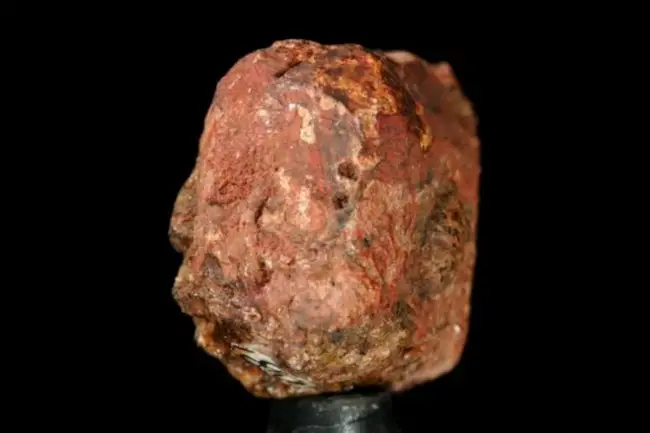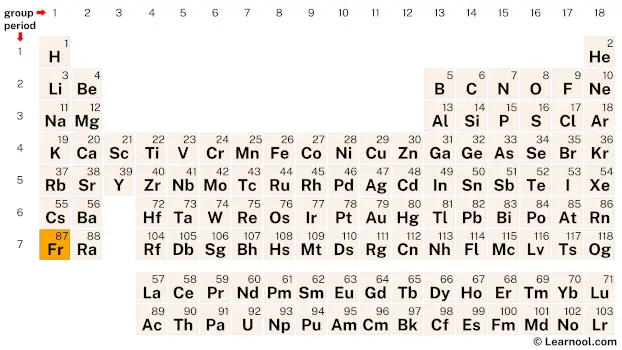
Francium (Fr) is a chemical element of the periodic table, located in group 1 and period 7, and has the atomic number 87. This element is named after France, the homeland of the discoverer Marguerite Perey. Francium is the heaviest chemical element of group 1 and the second most electropositive element. It is considered as one of the radioactive elements and is the second rarest element after astatine.
Dmitri I. Mendeleev, a Russian chemist, predicted the existence of francium in his periodic classification of elements. In 1939, Marguerite Perey finally discovered the element at the Curie Institute in Paris, France.[1] The element occurs naturally in small amounts in uranium minerals, but scientists believe that there is probably less than a kilogram of francium available in Earth’s crust. In the laboratory, francium can be synthesized using a special process, but it is not found naturally in large quantities.
There are 34 known isotopes of francium, which have atomic masses ranging from 199 to 232. 221Fr and 223Fr are the only naturally occurring isotopes of francium, while all the others are synthetic. Francium’s most stable isotope 223Fr has a half-life of only 22 minutes. It is extremely rare that another francium isotope with a longer half-life would ever be found or created.
On periodic table
| group | ⇨ | 1 | 2 | 3 | 4 | 5 | 6 | 7 | 8 | 9 | 10 | 11 | 12 | 13 | 14 | 15 | 16 | 17 | 18 |
| period | ⇩ | ||||||||||||||||||
| 1 | 1 H  Hydrogen |
2 He  Helium |
|||||||||||||||||
| 2 | 3 Li  Lithium |
4 Be  Beryllium |
5 B  Boron |
6 C  Carbon |
7 N  Nitrogen |
8 O  Oxygen |
9 F  Fluorine |
10 Ne  Neon |
|||||||||||
| 3 | 11 Na  Sodium |
12 Mg  Magnesium |
13 Al  Aluminium |
14 Si Silicon |
15 P  Phosphorus |
16 S  Sulfur |
17 Cl  Chlorine |
18 Ar  Argon |
|||||||||||
| 4 | 19 K  Potassium |
20 Ca  Calcium |
21 Sc  Scandium |
22 Ti  Titanium |
23 V  Vanadium |
24 Cr  Chromium |
25 Mn  Manganese |
26 Fe  Iron |
27 Co  Cobalt |
28 Ni  Nickel |
29 Cu  Copper |
30 Zn  Zinc |
31 Ga  Gallium |
32 Ge  Germanium |
33 As  Arsenic |
34 Se  Selenium |
35 Br  Bromine |
36 Kr  Krypton |
|
| 5 | 37 Rb  Rubidium |
38 Sr  Strontium |
39 Y  Yttrium |
40 Zr  Zirconium |
41 Nb  Niobium |
42 Mo  Molybdenum |
43 Tc  Technetium |
44 Ru  Ruthenium |
45 Rh  Rhodium |
46 Pd  Palladium |
47 Ag  Silver |
48 Cd  Cadmium |
49 In  Indium |
50 Sn  Tin |
51 Sb  Antimony |
52 Te  Tellurium |
53 I  Iodine |
54 Xe  Xenon |
|
| 6 | 55 Cs  Caesium |
56 Ba  Barium |
72 Hf  Hafnium |
73 Ta  Tantalum |
74 W  Tungsten |
75 Re  Rhenium |
76 Os  Osmium |
77 Ir  Iridium |
78 Pt  Platinum |
79 Au  Gold |
80 Hg  Mercury |
81 Tl  Thallium |
82 Pb  Lead |
83 Bi  Bismuth |
84 Po  Polonium |
85 At  Astatine |
86 Rn  Radon |
||
| 7 | 87 Fr Francium |
88 Ra  Radium |
104 Rf  Rutherfordium |
105 Db  Dubnium |
106 Sg  Seaborgium |
107 Bh  Bohrium |
108 Hs  Hassium |
109 Mt  Meitnerium |
110 Ds  Darmstadtium |
111 Rg  Roentgenium |
112 Cn  Copernicium |
113 Nh  Nihonium |
114 Fl  Flerovium |
115 Mc  Moscovium |
116 Lv  Livermorium |
117 Ts  Tennessine |
118 Og  Oganesson |
||
| 57 La  Lanthanum |
58 Ce  Cerium |
59 Pr  Praseodymium |
60 Nd  Neodymium |
61 Pm  Promethium |
62 Sm  Samarium |
63 Eu  Europium |
64 Gd  Gadolinium |
65 Tb  Terbium |
66 Dy  Dysprosium |
67 Ho  Holmium |
68 Er  Erbium |
69 Tm  Thulium |
70 Yb  Ytterbium |
71 Lu  Lutetium |
|||||
| 89 Ac  Actinium |
90 Th  Thorium |
91 Pa  Protactinium |
92 U  Uranium |
93 Np  Neptunium |
94 Pu  Plutonium |
95 Am  Americium |
96 Cm  Curium |
97 Bk  Berkelium |
98 Cf  Californium |
99 Es  Einsteinium |
100 Fm  Fermium |
101 Md  Mendelevium |
102 No  Nobelium |
103 Lr  Lawrencium |
|||||
| – s block |
Francium is an s-block element, situated in the first column and the seventh row of the periodic table. Its atomic number is 87 and its symbol is Fr.
Element information
 |
|
 |
|
| Origin of name | named after France, the homeland of the discoverer Marguerite Perey |
| Symbol | Fr |
| Atomic number (Z) | 87 |
| Atomic mass | (223) |
| Block | s-block |
| Group | 1 |
| Period | 7 |
| Classification | Alkali metal |
| Covalent radius | 260 pm (extrapolated) |
| Van der Waals radius | 348 pm (extrapolated) |
| Melting point | 27 ℃, 81 ℉, 300 K |
| Boiling point | 677 ℃, 1251 ℉, 950 K |
| Electron configuration | [Rn] 7s1 |
| Electrons per shell | 2, 8, 18, 32, 18, 8, 1 |
| Learn how to draw: Francium Bohr model | |
| Crystal structure | Body-centered cubic (bcc) (extrapolated) |
| Phase at r.t | Solid |
| Density near r.t | 2.48 g/cm3 (estimated) |
| Natural occurrence | From decay |
| Oxidation state | +1 |
| Electronegativity (Pauling scale) | >0.79 |
| Protons Neutrons Electrons |
87 136 87 |
| Learn how to find: Francium protons neutrons electrons | |
| Valence electrons | 1 |
| Learn how to find: Francium valence electrons | |
| CAS number | 7440-73-5 |
| Discovered by | Marguerite Perey in 1939 |
History

Mendeleev believed it was possible to discover an element with atomic number 87 in nature as early as 1870. After this prediction, there were multiple claims made by scientists claiming to have found this element, but there were also denials and counterclaims from other scientists. Marguerite Catherine Perey, a French chemist, eventually discovered francium in 1939 while examining the decay sequence of actinium.
The element discovered by Perey was named francium in honor of her home country of France. In 1949, the International Union of Chemists (IUC) officially recognized the name and assigned the symbol Fr, to the element.[2] Before it was discovered, the element was known as eka-caesium or ekacaesium due to the belief that it existed below caesium in the periodic table.
Production
Francium can be made in a laboratory by shooting a beam of oxygen-18 atoms at a target made of gold-197 using a special machine called a linear accelerator. This process was first developed at the physics department of Stony Brook University of New York in 1995. Alternatively, francium can be produced by bombarding thorium with protons, deuterons, or helium ions. Or by bombarding radium with neutrons.
Applications
Francium is one of a very few elements that has no practical usage outside of basic scientific research, mostly due to its extremely short half-life.[3]
Interesting facts
Francium’s most stable isotope Francium-223 has a half-life of only 22 minutes.
Prior to its discovery, the element was known as eka-caesium.
Francium is never found in bulk, and is available only about 30 grams in the Earth’s crust.[4]
Francium is the second most electropositive element.
Francium has only two naturally occurring isotopes, Francium-221 and Francium-223.
Francium was one of the last elements to be identified among all naturally occurring elements.
Related
More elements
References
2. Chemical Information for Element 87 – Francium – Andyscouse
3. It’s Elemental – The Element Francium
4. Finding francium | Nature Chemistry
External links
- https://www.rsc.org/periodic-table/element/87/francium
- https://www.britannica.com/science/francium
- https://en.wikipedia.org/wiki/Francium
- https://www.chemicool.com/elements/francium.html
- https://pubchem.ncbi.nlm.nih.gov/element/Francium
- https://www.livescience.com/39582-what-is-francium.html
- https://www.thoughtco.com/francium-element-facts-606535
Deep
Learnool.com was founded by Deep Rana, who is a mechanical engineer by profession and a blogger by passion. He has a good conceptual knowledge on different educational topics and he provides the same on this website. He loves to learn something new everyday and believes that the best utilization of free time is developing a new skill.
